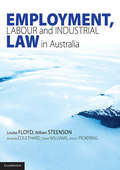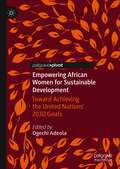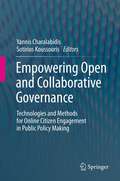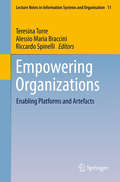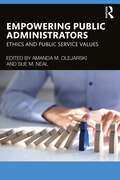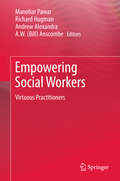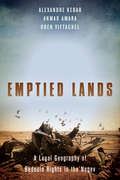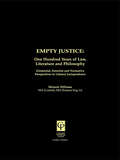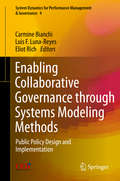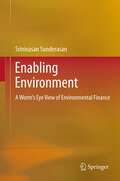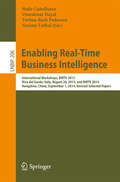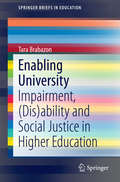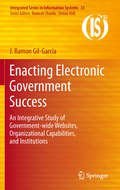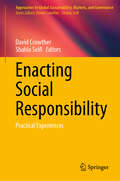- Table View
- List View
Employment and Labour Relations Law in the Premier League, NBA and International Rugby Union
by Leanne O'LearyThis book describes the regulatory framework and organisation of three professional team sports competitions. It examines how the monopolistic, private regulation of the National Basketball Association, Premier League Football and International Rugby Union can impinge upon the employment of professional players. It provides a comparative analysis between the sports on issues such as salary caps, nationality restrictions and the acquisition of a player's intellectual property. It draws conclusions regarding the legal, economic and political factors which balance the commercial and regulatory interests of the governing body and the clubs, with the employment rights of players. The book is important reading for scholars and practitioners in the fields of international sports law, employment law, competition law, European law and human rights law. It is also highly recommended for students at undergraduate and postgraduate levels taking modules and courses in Sports Law or Sports Business Management.
Employment, Labour and Industrial Law in Australia
by Daniel Williams Louise Floyd William Steenson Amanda Coulthard Anne C. PickeringEmployment, Labour and Industrial Law in Australia provides a comprehensive, current and accessible resource for the undergraduate and Juris Doctor student. With a social and political background to the law, this text provides insightful legal analysis underscored by practical business experience, while exploring key principles through a close evaluation of laws and lively discussion of prominent cases. Recognising the multi-faceted nature of the subject, the authors have included content on employment, labour and industrial law in the one text, while also presenting critical topics not often dealt with, namely: • current and In-depth analysis of trade union regulation • public work including the public sector, the judiciary and academics • workplace health and safety including worker's compensation, bullying, anti-discrimination and taxation • emerging issues including topics such as transnational and international employment law, migration and employment, as well as volunteers and work experience. To maintain currency within this rapidly changing area of law, the text has a website which will include updates for any major developments in the field as well as responses to end-of-chapter questions. Written by respected academics and practicing lawyers in the field, Employment, Labour and Industrial Law in Australia is a relevant and contemporary guide to this fascinating area of law. Explores employment, labour and industrial law in one volume. Contains current and in-depth analysis of trade union regulation. Includes content on the public sector, The Judiciary and academics, rarely covered in an undergraduate law text book.
Empowering African Women for Sustainable Development: Toward Achieving the United Nations' 2030 Goals
by Ogechi AdeolaThis edited volume assesses the progress that sub-Saharan African countries have made towards gender equality and offers strategies that can be used to empower African women to contribute to the fulfilment of the United Nations’ (UN) 2030 sustainable development goals (SDGs). The contributing authors consider the goals identified during the 1995 United Nations World Conference on Women and the 2015 UN World Conference on Sustainable Development in New York—including no poverty, healthy life, quality education, gender equality, peace and justice, reduced inequalities, and decent work and economic growth—and document the advances made on these goals, with a special emphasis on African women’s experiences. They provide innovative ideas for accelerating achievement of the SDGs and address challenges and opportunities in tourism, business, politics, entrepreneurship, academia, financial inclusion, and the digital gender divide. This book will be of value to policymakers, non-profit organisations focused on gender equality and sustainable development, and academics and scholars who teach and study gender-related issues in the African continent.
Empowering Open and Collaborative Governance: Technologies and Methods for Online Citizen Engagement in Public Policy Making
by Yannis Charalabidis Sotirios KoussourisThe use of information and communication technologies to support public administrations, governments and decision makers has been recorded for more than 20 years and dubbed e-Government. Moving towards open governance roadmaps worldwide, electronic participation and citizen engagement stand out as a new domain, important both for decision makers and citizens; and over the last decade, there have been a variety of related pilot projects and innovative approaches. With contributions from leading researchers, Charalabidis and Koussouris provide the latest research findings such as theoretical foundations, principles, methodologies, architectures, technical frameworks, cases and lessons learnt within the domain of open, collaborative governance and online citizen engagement. The book is divided into three sections: Section one, "Public Policy Debate Foundations," lays the foundations regarding processes and methods for scoping, planning, evaluating and transforming citizen engagement. The second section, "Information and Communication Technologies for Citizen Participation," details practical approaches to designing and creating collaborative governance infrastructures and citizen participation for businesses and administrations. Lastly, the third section on "Future Research Directions of Open, Collaborative ICT-enabled Governance" provides a constructive critique of the developments in the past and presents prospects regarding future challenges and research directions. The book is mainly written for academic researchers and graduate students working in the computer, social, political and management sciences. Its audience includes researchers and practitioners in e-Governance, public administration officials, policy and decision makers at the local, national and international level engaged in the design and creation of policies and services, and ICT professionals engaged in e-Governance and policy modelling projects and solutions.
Empowering Organizations
by Teresina Torre Alessio Maria Braccini Riccardo SpinelliThis book presents a collection of original research papers focusing on the enabling aspects of Information and Communication Technologies. In particular, it focuses on the two topics of digital platforms and digital artefacts, and discusses their role in enabling organizations to achieve specific goals, to exploit innovative value propositions, or to leverage innovative coordination mechanisms. Adopting a multidisciplinary perspective on a variety of information systems topics, the book offers interesting insights for IS managers, business managers, and policymakers alike. It is based on a selection of the best research papers - original double-blind peer-reviewed contributions - presented at the annual conference of the Italian chapter of the AIS, held in Genoa (Italy) in November 2014.
Empowering Public Administrators: Ethics and Public Service Values
by Amanda M. Olejarski and Sue M. NealPublic administrators need to be empowered to make difficult decisions. Acting in the public interest often means doing what is ethical even when it is an unpopular choice. Yet, too often, public servants at the local, state, and federal levels internalize the notion that their hands are tied and that they are limited in their ability to effect change. Empowering Public Administrators: Ethics and Public Service Values provides a much-needed antidote to inaction, offering a new lens for viewing administrative decision-making and behavior. This book makes a case for bringing historically significant theories to the forefront of public service ethics by applying them to a series of current ethical challenges in practice. Exploring administrative discretion as modern bureaucrats govern public affairs in a political context, this collection builds on the normative foundations of public administration and provides readers with a scaffold for understanding and practicing public service values. Questions for discussion and applications to practice are included in each chapter making this collection of interest to public affairs master’s and doctoral students as well as public service practitioners.
Empowering Public Administrators: Ethics and Public Service Values
by Amanda M. Olejarski and Sue M. NealPublic administrators need to be empowered to make difficult decisions. Acting in the public interest often means doing what is ethical even when it is an unpopular choice. Yet, too often, public servants at the local, state, and federal levels internalize the notion that their hands are tied and that they are limited in their ability to effect change. Empowering Public Administrators: Ethics and Public Service Values provides a much-needed antidote to inaction, offering a new lens for viewing administrative decision-making and behavior.This book makes a case for bringing historically significant theories to the forefront of public service ethics by applying them to a series of current ethical challenges in practice. Exploring administrative discretion as modern bureaucrats govern public affairs in a political context, this collection builds on the normative foundations of public administration and provides readers with a scaffold for understanding and practicing public service values. Questions for discussion and applications to practice are included in each chapter making this collection of interest to public affairs master’s and doctoral students as well as public service practitioners.
Empowering Social Workers
by Andrew Alexandra Manohar Pawar A. W. Bill Anscombe Richard HugmanThis book demonstrates the central role of ethical character in effective social work practice. Showcasing select biographies of social workers, it reveals how skilled practitioners have developed such core virtues as compassion, love, commitment, prudence, respect for human dignity and a critical sense of social justice through the course of their working lives, and how they apply these virtues in a wide variety of settings and situations to enhance the well-being of the people and communities they work with. As such, the book offers a powerful and inspiring resource to help educators, students and practitioners understand the unbreakable link between what social workers and other social welfare and social development professionals do and who they are, and thereby cultivate core qualities that should be promoted. "Pawar, Hugman, Alexandra and Anscombe have found a novel and creative way to explore virtues in social work by examining the career contributions of a group of social work practitioners engaged in 'virtuous action'. Their stories are inspiring and they provide much-needed role models for students and practitioners embarking on empowering practice" - Dr. Mel Gray, Professor of Social Work, The University of Newcastle. New South Wales, Australia. "In an age where the virtues of truth, cooperation and "doing the right thing" are increasingly being eroded in public life, this book serves as both an inspiration and invaluable resource to all social work practitioners seeking to reflect on, and improve their practice" - Dr. Martin Ryan, Social Worker, Counsellor/Community Educator, Jesuit Social Services, Melbourne. "The editors are to be commended for examining the virtuous characters of these ten professional social workers. The use of detailed biographies is an innovative and important approach which helps us to appreciate just what a tremendous impact the virtues can have. " - Dr. Christian B. Miller, A. C. Reid Professor of Philosophy, Director, The Character Project, Wake Forest University, USA.
Empowering Women
by Mary Hallward-Driemeier Tazeen HasanThe importance of property rights in providing the incentive to invest, work hard, and innovate has been recognized for centuries. Yet, many women in Africa do not have the same property rights or formal legal capacity enjoyed by men. Empowering Women: Legal Rights and Economic Opportunities in Africa documents the extent to which the legal capacity and property rights vary for women and men, and analyzes the impact this has on women's economic opportunities. The book introduces the "Women's Legal Economic Empowerment Database - Africa (Women LEED Africa). " This database covers all 47 countries in Sub-Saharan Africa, providing indicators and links to constitutions, ratified international conventions, and domestic statutes where there are gender gaps in legal capacity and property rights. It shows how and where, despite universal constitutional recognition of non-discrimination, many countries have exceptions in areas of marriage, ownership, and control over property and inheritance. With less secure property rights, women in these countries do not have the same ability - or incentive - to accumulate and control assets and thus to access finance or to grow their businesses. After laying out the various gender gaps in legal capacity and property rights, the book addresses the additional challenges stemming from legal systems with a multiplicity of sources of law. Overlapping legal systems themselves add uncertainty to defining women's economic rights. The authors use case law to trace out the implications for women's rights and to provide examples of effective reforms. The book recognizes that beyond de jure differences, women may face greater practical constraints in having their rights protected. This book spells out specific steps that can be taken to address gender gaps both in formal property rights and in practical constraints in accessing justice.
Emprender para cambiar el mundo: El impacto social de la innovación
by Andy Freire Santiago A. SenaAndy Freire con Santiago A. Sena nos presentan a los emprendedores sociales, quienes demuestran que el impacto social y la sostenibilidad económica no son lógicas contrapuestas, sino una alianza innovadora que cambia paradigmas en todo el mundo. Mientras el futuro aparece amenazante (la pérdida masiva de empleo por la automatización, el calentamiento global y las crisis humanitarias), estos emprendedores traen respuestas: generar un impacto social positivo y sustentable desde empresas que proveen bienes y servicios, tienen clientes, generan ganancias, son rentables y, al mismo tiempo, solucionan problemas sociales concretos. Su experiencia deja en claro que hay una nueva forma de encarar la vida laboral. El capitalismo puede ser salvaje, pero los emprendedores sociales se comprometen a domarlo y humanizarlo en beneficio de la sociedad.
Emptied Lands: A Legal Geography of Bedouin Rights in the Negev
by Ahmad Amara Oren Yiftachel Alexandre KedarEmptied Landsinvestigates the protracted legal, planning, and territorial conflict between the settler Israeli state and indigenous Bedouin citizens over traditional lands in southern Israel/Palestine. The authors place this dispute in historical, legal, geographical, and international-comparative perspectives, providing the first legal geographic analysis of the "dead Negev doctrine" used by Israel to dispossess and forcefully displace Bedouin inhabitants in order to Judaize the region. The authors reveal that through manipulative use of Ottoman, British and Israeli laws, the state has constructed its own version ofterra nullius. Yet, the indigenous property and settlement system still functions, creating an ongoing resistance to the Jewish state.Emptied Landscritically examines several key land claims, court rulings, planning policies and development strategies, offering alternative local, regional, and international routes for justice.
Empty Justice: One Hundred Years of Law Literature and Philosophy
by Melanie WilliamsUtilising literature as a serious source of challenges to questions in philosophy and law, this book provides a fresh perspective not only upon the inculcation of the legal subject, but also upon the relationship between modernism, postmodernism and how such concepts might evolve in the construction of community ethics. The creation and role of the legal subject is just one aspect of jurisprudential enquiry now attracting much attention. How do moral values act upon the subject? How do moral 'systems' impinge upon the subject - jurist and judged - throughout the 20th century, when religious values are called into question, when 'existential' doubt prevails? To what extent do issues of gender and identity inform these questions? Many sources can provide insights into these issues: this book intends to concentrate upon fiction as just such a resource. However it is not just another law and literature compilation. Spanning the last century, each chapter will attempt to fulfil four objectives: to identify key texts in relation to a given period; to look for linked legal and philosophical developments from that period; to establish fresh links from these sources regarding concrete doctrinal, or practical legal questions, and finally draw a more general inference about the legal subject and the frequently less evident feminine citizen-subject. Central to this approach will be the consideration of contemporary case law and legal materials as social documents of the relationship between law and the wider community.
Empty Promises: Why Workplace Pension Law Doesn’t Deliver Pensions
by Elizabeth J. ShiltonWorkplace pensions are a vital part of Canada's retirement income system, but these plans have reached a state of crisis as a result of their low coverage and inadequate, insecure, and unequally distributed benefits. Reviewing pension plans through a legal and historical lens, Empty Promises reveals the paradoxical effects and inevitable failure of a pension system built on the interests of employers rather than employees. Elizabeth Shilton examines the evolution of pension law in Canada from the 1870s to the early twenty-first century, highlighting the foreseeably futile struggle of legislators to create and sustain employees' pension rights without undermining employers' incentives. The current system gives employers considerable discretion and control in pension design and administration. Shilton appeals for a model that is not hostage to business interests. She recommends replacing today's employer-controlled systems with pensions shaped by the public interest, expanding mandatory broad-based or state-pension systems such as the Canada Pension Plan to generate pensions that respond to the changing workplace and address the needs and interests of retirees. Engaging with the long-running debate on whether Canadians should look to government or to the private sector for retirement income security, Empty Promises is a crucial work concerned with the future of the Canadian retirement system.
Empty Promises: Why Workplace Pension Law Doesn’t Deliver Pensions
by Elizabeth ShiltonWhy a voluntary, employer-based pension system does not deliver adequate and secure retirement income for most Canadians.
En legítima defensa: Yakiri Rubio y la bran batalla contra la violencia machista y el sistema penal
by Ana Katiria Suárez CastroLa estremecedora historia de la joven y su larga lucha por obtener libertad y justicia. Una narración cruda e intensa de una mujer que se enfrentó a la violencia machista, a las instituciones patriarcales, a la corrupción del sistema penal... Y ganó. En diciembre de 2013, la joven Yakiri Rubio fue secuestrada por dos hombres que la condujeron a un hotel para violarla. Después de ultrajarla, uno de ellos intentó asesinarla. Ella acabó matando al agresor en defensa propia; sin embargo, la acusaron de homicidio calificado y la encarcelaron. La autora de este libro, Ana Katiria Suárez, es la abogada penalista que defendió a Yakiri Rubio. En una carrera contra el tiempo, después de haber tenido acceso a un expediente mutilado, su objetivo desde el primer momento fue demostrar que Yakiri actuó en legítima defensa tras haber sufrido una violación sexual. Con la pasión que caracterizó su defensa, la autora relata los pormenores de un proceso viciado desde el origen, repleto de omisiones, fallas y contubernios entre los delincuentes y la autoridad. Muy pronto, el caso se convirtió en una lucha personal por los derechos humanos y en una cruzada jurídica con perspectiva de género. Otros autores han opinado: "¡Qué sería de este país de machos donde campean la violencia, la misoginia y el odio, sin mujeres como Ana Katiria! ¡Qué sería de nosotros sin esas voces, como la suya, que no sólo claman justicia, sino que son capaces de arrancársela a un régimen que sistemáticamente nos la niega!" -Epigmenio Ibarra-
Enabling Acts
by Lennard J. Davis<P>The first significant book on the history and impact of the ADA--the "eyes on the prize" moment for disability rights. <P>The Americans with Disabilities Act (ADA) is the widest-ranging and most comprehensive piece of civil rights legislation ever passed in the United States, and it has become the model for disability-based laws around the world. Yet the surprising story behind how the bill came to be is little known. <P>In this riveting account, acclaimed disability scholar Lennard J. Davis delivers the first behind-the-scenes and on-the-ground narrative of how a band of leftist Berkeley hippies managed to make an alliance with upper-crust, conservative Republicans to bring about a truly bipartisan bill. <P>Based on extensive interviews with all the major players involved including legislators and activists, Davis recreates the dramatic tension of a story that is anything but a dry account of bills and speeches. Rather, it's filled with one indefatigable character after another, culminating in explosive moments when the hidden army of the disability community stages scenes like the iconic "Capitol Crawl" or an event some describe as "deaf Selma," when students stormed Gallaudet University demanding a "Deaf President Now!" <P>From inside the offices of newly formed disability groups to secret breakfast meetings surreptitiously held outside the White House grounds, here we meet countless unsung characters, including political heavyweights and disability advocates on the front lines. "You want to fight?" an angered Ted Kennedy would shout in an upstairs room at the Capitol while negotiating the final details of the ADA. Congressman Tony Coelho, whose parents once thought him to be possessed by the devil because of his epilepsy, later became the bill's primary sponsor. There's Justin Dart, adorned in disability power buttons and his signature cowboy hat, who took to the road canvassing fifty states, and people like Patrisha Wright, also known as "The General," Arlene Myerson or "the brains," "architect" Bob Funk, and visionary Mary Lou Breslin, who left the hippie highlands of the West to pursue equal rights in the marble halls of DC. <P>Published for the twenty-fifth anniversary of the ADA, Enabling Acts promises to ignite readers in a discussion of disability rights by documenting this "eyes on the prize" moment for tens of millions of American citizens.
Enabling Collaborative Governance through Systems Modeling Methods: Public Policy Design and Implementation (System Dynamics for Performance Management & Governance #4)
by Luis F. Luna-Reyes Carmine Bianchi Eliot RichThis volume constitutes a first approximation for the use of systems approaches and dynamic performance management as tools for collaborative governance. The chapters examine models and simulations used in some specific systems approaches, which contribute to facilitating problem focus and collective understanding of collaborative governance, especially in the area of performance management. The explicit connection between resources and outcomes promoted by this view helps managers to understand better how to improve policy and to create positive outcomes that create public value.
Enabling Environment
by Srinivasan SunderasanEnabling Environment is as real as it gets. The global commons are jointly owned and their inhabitants are jointly obligated to ensure their preservation. In the face of protracted negotiations, convoluted documentation, discord, and incessant bickering among scientists, activists, pressure groups of various hues, politicians and negotiators, very often the people on the ground are ignored or taken for granted. In the meantime, life meanders along. It is these 'everyday individuals' who make consumption-related choices on their lifestyles, travel or on preferring certain products or services over others. Enabling Environment puts the individual front and center. Ecosystem services need to be recognized, appropriately priced and the costs allocated to the agents concerned. Enabling Environment is about defining economic and non-economic incentive structures and utilizing them to arrive at pro-environmental outcomes. This collection of articles illustrates the use of existing social, economic and regulatory structures, and the financial architecture and instruments, suitably modified or extended, to help internalize the environmental externality.
Enabling Real-Time Business Intelligence
by Malu Castellanos Umeshwar Dayal Torben Bach Pedersen Nesime TatbulThis book constitutes the thoroughly refereed conference proceedings of the 7th International Workshop on Business Intelligence for the Real-Time Enterprise, BIRTE 2013, held in Riva del Garda, Italy, in August 2013 and of the 8th International Workshop on Business Intelligence for the Real-Time Enterprise, BIRTE 2014, held in Hangzhou, China, in September 2014, in conjunction with VLDB 2013 and 2014, the International Conference on Very Large Data Bases. The BIRTE workshop series provides a forum for the discussion and advancement of the science and engineering enabling real-time business intelligence and the novel applications that build on these foundational techniques. This volume contains five full, two short, and two demo papers, which were carefully reviewed and selected with an acceptance rate of 45%. In addition, one keynote and three invited papers are included.
Enabling Secure and Privacy Preserving Communications in Smart Grids
by Hongwei LiThis brief focuses on the current research on security and privacy preservation in smart grids. Along with a review of the existing works, this brief includes fundamental system models, possible frameworks, useful performance, and future research directions. It explores privacy preservation demand response with adaptive key evolution, secure and efficient Merkle tree based authentication, and fine-grained keywords comparison in the smart grid auction market. By examining the current and potential security and privacy threats, the author equips readers to understand the developing issues in smart grids. The brief is designed for researchers and professionals working with computer communication networks and smart grids. Graduate students interested in networks and communication engineering will also find the brief an essential resource.
Enabling University
by Tara BrabazonThis work takes the most recent, interdisciplinary research and demonstrates how to make higher education institutions open, accessible and socially just for staff and students with disabilities. Combining the scholarly fields of media platform management, information literacy, internet studies, mobility studies and disability studies, this book offers a guide and method to consider how students and staff with differing needs move through university processes, spaces and interfaces. It captures the challenges and potentials of both the online and offline university. The key concept of the book is universal design. This term and theory is used to move beyond the medical and social model of disability that disconnect and separate the issues of disability and impairment from core societal concerns. This book confirms that most of us will be touched by impairment through our lives. When matched with the necessity to retrain and gain new skills for a post-recession future, there must be a renewed commitment to not only the widening participation agenda of higher education, but also the enabling of universities for men and women with impairments.
Enabling and Safeguarding Personalized Medicine (Data Science, Machine Intelligence, and Law #7)
by Arianna Rossi Federica Casarosa Francesca GennariThis open-access volume provides a comprehensive guide to the most pressing challenges arising from the technologies that enable personalized medicine. It brings together theoretical, empirical, and case study-based contributions that span across disciplinary boundaries to examine related problems and propose solutions critically. Personalized medicine is the next frontier in scientific, public health, and commercial advancements. By recognizing the uniqueness of each human body, data-driven treatments and digital, robotic devices are being increasingly developed to enable patients and medical personnel to benefit from highly accurate and personalized diagnoses and therapies. Healthcare customization is based on predictive, preventive, personalized, and participatory elements – each of which requires an interplay between healthcare systems, medical personnel, patients, as well as bioengineers, economists, regulators, lawyers, and business owners. If the goal of more proactive patient inclusion is to enhance the efficacy of personalized medical interventions, it is also paramount to evaluate whether the adoption of customized solutions is sustainable from both economic and organizational perspectives. Legal norms provide the framework in which the development of new medical devices, the sharing of data for the public good, and the provision of healthcare may occur. This area of research and practice is regulated by a complex mix of norms concerning personal and non-personal data, AI governance, cybersecurity, health law, and liability regimes. In ever-evolving domains where some regulations still need to be defined, approved, or implemented, researchers and practitioners need guidance to enable the safe-by-design development of medical technologies. The book is organized in three sections: I) &“Facilitating and Protecting Personalized Medicine,&” which revolves around the mechanisms that enable the sharing and reuse of health data within the Common European Data Spaces, seeks to address the cybersecurity challenges posed by medical technologies, and critically discusses the definition of scientific research in recent legislative efforts; II) &“Scoping Challenges Through the Players in the Personalized Medicine Ecosystem,&” which gathers varied interdisciplinary insights from scholars and practitioners in the fields of medicine, economics, engineering, education and compliance; and III) &“Challenges of Personalized Medicine for Liability,&” which focuses on the challenges that personalized data-driven medicine poses for traditional and novel liability regimes.
Enacting Electronic Government Success
by J. Ramon Gil-GarciaMany countries around the world are investing a great amount of resources in government IT initiatives. However, few of these projects achieve their stated goals and some of them are complete failures. Therefore, understanding e-government success has become very important and urgent in recent years. In order to develop relevant knowledge about this complex phenomenon, researchers and practitioners need to identify and assess what are the main conditions, variables, or factors that have an impact on e-government success. However, before being able to evaluate these impacts, it is necessary to define what e-government success is and what some e-government success measures are. This book presents a review of both e-government success measures and e-government success factors. It also provides empirical evidence from quantitative analysis and two in-depth case studies. Although based on sound theory and rigorous empirical analysis, the book not only significantly contributes to academic knowledge, but also includes some practical recommendations for government officials and public managers. Theoretically, the book proposes a way to quantitatively operationalize Fountain's enactment framework. Based on the institutional tradition, the technology enactment framework attempts to explain the effects of organizational forms and institutional arrangements on the information technology used by government agencies. According to Fountain (1995; 2001) the technology enactment framework pays attention to the relationships among information technology, organizations, embeddedness, and institutions. This framework is very well known in the e-government field, but is normally used for qualitative analysis and there is no previous proposal of how to use it with quantitative data. The book proposes variables to measure each of the different constructs in this framework and also tests the relationships hypothesized by Fountain's theory. Finally, using the advantages of the selected quantitative analysis technique (Partial Least Squares), the study also proposes some adjustments and extensions to the original framework in a theory building effort. Methodologically, the book reports on one of the first multi-method studies in the field of e-government in general and e-government success in particular. This study uses a nested research design, which combines statistical analysis with two in depth case studies. The study begins with a statistical analysis using organizational, institutional, and contextual factors as the independent variables. An overall score representing e-government success in terms of the functionality of state websites is the dependent variable. Second, based on the statistical results two cases are selected based on their relative fitness to the model (residuals) and their position in the general ranking of website functionality (which includes four different measures). In order to complement the results of the statistical analysis, case studies were developed for the two selected states (New York and Indiana), using semi-structured interviews and document analysis. In terms of the statistical analysis, the book constitutes one of the first applications of Partial Least Squares (PLS) to an e-government success study. PLS is a structural equations modeling (SEM) technique and, therefore, allows estimating the measurement model and the structural model simultaneously. The use of this sophisticated statistical strategy helped to test the relationships between e-government success and different factors influencing it, as well as some of the relationships between several of the factors, thus allowing exploring some indirect effects too.
Enacting Social Responsibility: Practical Experiences (Approaches to Global Sustainability, Markets, and Governance)
by David Crowther Shahla SeifiThis book explores the pervasive nature of socially responsible behavior, which has evolved beyond Corporate Social Responsibility (CSR) to become an integral part of all organizational activities and investments. It presents how socially responsible decision-making is now embedded within the core operations of organizations globally. Despite the widespread recognition of its importance, there remains a significant gap in understanding the practical effects of such behavior. This book aims to bridge that gap by providing a comprehensive analysis of the real-world impacts of social responsibility. Taking a global perspective, the book investigates the practical outcomes of socially responsible actions across various countries and sectors. It explores how organizations worldwide implement and benefit from these practices, offering a rich tapestry of observations and insights. By examining a diverse range of fields, the book presents a holistic view of the effects of socially responsible behavior, highlighting both successes and challenges. Through its detailed analysis and global scope, this book offers valuable contributions to the ongoing discourse on social responsibility. It provides readers with a deeper understanding of how socially responsible practices are applied in different contexts and their tangible impacts. Whether you are a scholar, practitioner, or policymaker, this book serves as an essential resource for anyone interested in the practical implications of social responsibility in today’s interconnected world.
Enchiridion (Dover Thrift Editions)
by Epictetus George LongAlthough he was born into slavery and endured a permanent physical disability, Epictetus (ca. 50-ca. 130 AD) maintained that all people are free to control their lives and to live in harmony with nature. We will always be happy, he argued, if we learn to desire that things should be exactly as they are. After attaining his freedom, Epictetus spent his entire career teaching philosophy and advising a daily regimen of self-examination. His pupil Arrianus later collected and published the master's lecture notes; the Enchiridion, or Manual, is a distillation of Epictetus' teachings and an instructional manual for a tranquil life. Full of practical advice, this work offers guidelines for those seeking contentment as well as for those who have already made some progress in that direction. Translated by George Long.

